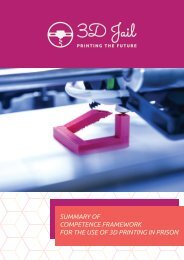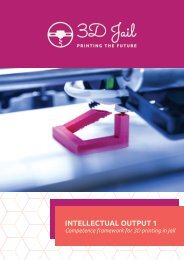Training models for the use of 3D printing technology in prison
3D Jail project further involves a training program for the training and development of trainers who are going to deliver the training program for inmates. Trainers are required to have basic computer, CAM and CAD skills. For the training of the trainers has also been planned an in-service training program to cover information on general characteristics of penitentiary institutions and inmates, use of the e-learning portal, and 3D printing.
3D Jail project further involves a training program for the training and development of trainers who
are going to deliver the training program for inmates. Trainers are required to have basic computer,
CAM and CAD skills. For the training of the trainers has also been planned an in-service training
program to cover information on general characteristics of penitentiary institutions and inmates, use
of the e-learning portal, and 3D printing.
Create successful ePaper yourself
Turn your PDF publications into a flip-book with our unique Google optimized e-Paper software.
●
help students and other incarcerated individuals prepare for release (e.g., applying for jobs,
financial aid, and benefits).
The implications for policy and practice include
●
●
permitting students to use secure personal mobile devices both in and outside of the
classroom; and
providing students with restricted Internet access.
ASSESSING
Our education system at all levels will leverage the power of technology to measure what matters and
use assessment data for continuous improvement.
To achieve this goal in correctional education, we recommend using advanced technologies to
●
●
provide students with access to online assessments (e.g., online high school equivalency tests
and industry-recognized certification exams) and digital badges; and
help instructors and administrators with measuring student learning gains and challenges,
evaluating program effectiveness, and driving program improvement.
The implications for policy and practice include
●
●
●
creating an online network with assessment vendors and connecting to the Internet before
and after assessments to upload test results;
aligning assessment policy with community-based education programs, which are moving to
an online-only platform for a number of assessments (e.g., CASAS); and
creating an environment where data are regularly collected, analyzed, and used for program
improvement purposes.
TEACHING
Professional educators will be supported individually and in teams by technology that connects them
to data, content, resources, expertise, and learning experiences that enable and inspire more effective
teaching for all students.
To achieve this goal in correctional education, we recommend using advanced technologies to
●
●
●
●
equip instructors with tools and resources (e.g., OERs) to enhance the classroom experience;
monitor student progress and individualize instruction through learning management systems
and computer-assisted instruction;
incorporate blended-learning, flipped classrooms, and other models and methods targeting
multi-proficiency-level adult students; and
provide instructors with access to professional development resources and opportunities,
such as communities of practice, to collaborate and learn from other instructors both inside
and outside secure classrooms.
The implications for policy and practice include
3DJail printing the future – IO2
11





